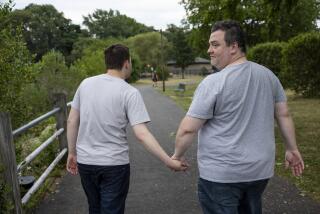Behavioral therapy effective in treating Tourette syndrome
- Share via
Tourette syndrome — a neurological disorder characterized by involuntary tics such as blinking, head-jerking and loud sounds — can be devastating for children, setting them up for teasing and ostracism, while the drugs used to treat the condition have significant side effects. Now a study has found that behavioral therapy may help lessen tics in children and teens about as effectively as medication.
In the study, released Tuesday in the Journal of the American Medical Assn., 126 children ages 9 to 17 who had Tourette or a chronic tic disorder were randomly assigned to 10 weeks of behavioral therapy designed to reduce the tics, or to a control group that received support therapy and education. About a third of all children were also on anti-tic medication. The study treatment included a functional intervention to better manage anxiety-producing social situations.
Some participants in the therapy group received “booster” treatments at three and six months after the 10-week therapy sessions.
At the end of the study, about 53% of the children in the therapy group were judged significantly improved, compared with 19% of the children in the control group. Tics worsened in one child in the therapy group and in four in the control group.
At six months, 87% of the children who completed therapy and had not dropped out of the study still showed benefits from the therapy.
The therapy group’s results were about the same as recent studies examining the effectiveness of medication, the study’s authors said. These drugs include antidepressants and anti-anxiety medications as well as antipsychotics such as risperidone and haloperidol. Some have side effects such as weight gain, lethargy and anxiety.
The therapy, called comprehensive behavioral intervention for tics, has several elements. The key component, habit reversal training, helps patients become more aware of the urge to tic, then teaches them to engage in a voluntary behavior — rhythmic breathing, perhaps — that competes with the tic. Though the therapy doesn’t suppress the urge to tic, it channels the urge into another, less noticeable behavior.
Habit reversal training has been used for decades to treat disorders such as trichotillomania (compulsive hair pulling or twisting), and compulsive nail biting and skin picking. Its use for treating Tourette syndrome has become more widespread in the last 10 years.
“We don’t look at the treatment as a cure for Tourette,” said John Piacentini, lead author of the study and a professor of psychiatry and biobehavioral sciences at UCLA. “We’re teaching the child an effective means of managing their tics — and in the best cases, they can learn to manage them until the tics do gradually disappear. More realistically, they can manage them so they don’t happen with such frequency that they significantly interfere with the child’s life.”
Although habit reversal training has gained more acceptance in recent years, Piacentini says that some critics have seen the therapy as simply replacing one tic with another.
But Peter Hollenbeck, professor of biological sciences at Purdue University and chairman of the Tourette Syndrome Assn.’s scientific advisory board, said the behavioral treatment puts the control in the hands of the person with Tourette.
“As opposed to saying, ‘Sit back and take your [medication] and hope for the best,’ this is a set of skills to learn,” he said. “This puts you in the position of being an active agent.”
Piacentini, who is director of UCLA’s Childhood OCD, Anxiety & Tic Disorders Program, said more work needed to be done to understand why a sizable number of children did not benefit from the therapy.
“We’re looking at the data to see if we can identify which factors were associated with the best response,” he said. “Maybe we need to revise the therapy, or combine it with therapies or medication.”
The researchers are also studying brain imaging before and after the therapy to see how the therapy may change the brain.
“Medicine may play an important role in treatment,” Piacentini added. “But it makes the most sense to start with behavioral treatment, since it’s safe and effective in many cases.”




